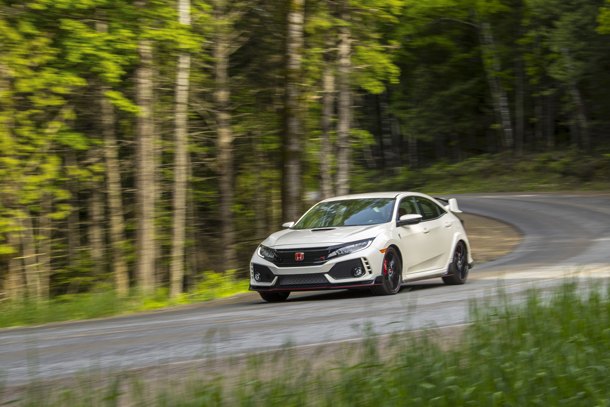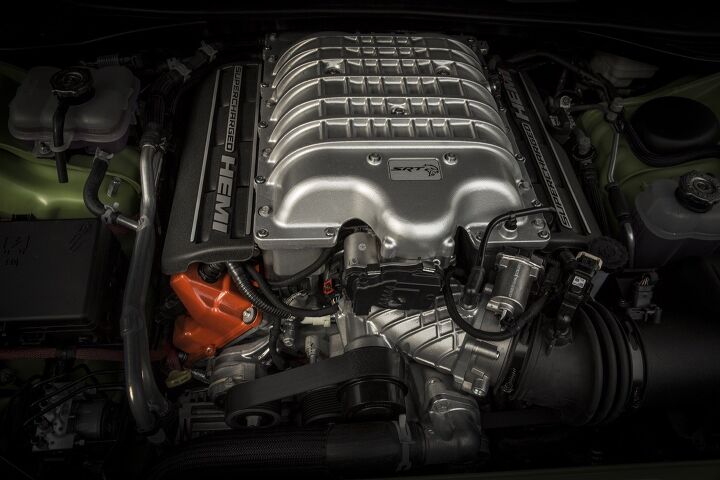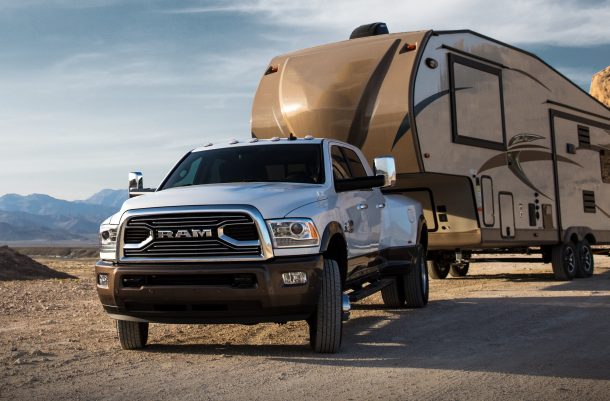#Engines
It's Crate Engine Day, Apparently - This Time, It's the Honda Civic Type R Mill
Between Mopar’s 707-horsepower Hellcat engine and Honda’s 306-horsepower turbocharged 2.0-liter from the Civic Type R, the crate engine gods have smiled on both axles today.
Like Mopar, Honda took advantage of this week’s SEMA show in Las Vegas to announce the availability of the front-drive monster’s engine in standalone form. No doubt this news immediately inspired visions of the cobbled-together HR-V Type R you really wanted, but be warned. This engine comes with an asterisk.
Ditch That Slant Six: Dodge Hellcat Powerplant Is Now Available as a Crate Engine
This should lead to more than a few odd pairings. Mopar, Fiat Chrysler Automobiles’ performance and aftermarket parts division, will now offer a Dodge SRT Hellcat engine — the company’s 707 horsepower, supercharged 6.2-liter V8 — minus the car.
Dubbed the “Hellcrate,” the warranty-backed engine and associated kit was unveiled Monday ahead of this week’s SEMA show in Las Vegas. This means Mopar fans looking to own a 707-hp beast have other options than just visiting an FCA dealer and signing on the dotted line for a new vehicle.
The Rotary's Returning, Says Mazda, But There's Some Things to Take Care of First
For five years now, Mazda has hinted, then promised, then reassured us that a rotary-powered sports car will return to the company’s lineup, ready to fill a spot left vacant by the departing RX-8 in 2012.
We’re still waiting and, Mazda now informs us, we’ll be waiting quite a bit longer. While the cylinderless gasoline engine holds promise as a range-extender in electrified vehicles (something powertrain chief Mitsuo Hitomi feels is a definite future use for the powerplant), that’s not something Wankel fans want to hear. They want to spin that engine up to eleventy billion rpm and drop the clutch.
It’ll happen, says Mazda’s senior managing executive officer, Kiyoshi Fujiwara, but something’s cropped up that pushed the rotary’s return to the back burner. That thing is the company’s gasoline compression ignition engine, the Skyactiv-X.
Boastful Toyota Exec Feels Little Sympathy For Foolish Rivals
If only other automakers were as sensible and wise as Toyota. If those companies held Toyota’s Magic 8 Ball, conjuring up all the right answers in the little purple window, they wouldn’t be so hasty to embark on risky ventures.
That’s the view of Toyota’s executive vice president, who’s apparently feeling pretty pleased with himself and his company. Didier Leroy broke from the automaker’s staid, stay-the-course-and-don’t-ruffle-feathers attitude at the Tokyo Motor Show this week, describing his rivals’ faults at a dinner held on the show’s sidelines.
Plunge headlong into electric vehicles? Sure, make wild long-term promises to customers, Leroy said. Toyota doesn’t do that. It just hands you a real car when it’s ready. Oh, and those diesels everyone’s worried about? Toyota fell out of love with them long before the word “dieselgate” left anyone’s lips.
Toyota’s feeling its oats.
Despite Technology Boost, Ford F-150's New Base Engine Still Guzzles More Gas Than the Upgrade
Think of the Ford F-150 pickup and one’s mind immediately turns to an excellent pair of EcoBoost V6 engines with 2.7 and 3.5 liters of displacement. And why wouldn’t you? Together, Ford’s twin-turbocharged V6 twins make up three-quarters of the model’s engine share. These beauties are the last word in full-size pickup torque, though the 2.7-liter is a wanderer that finds deserving homes in such models as the Ford Edge, Lincoln MKX, and Ford Fusion Sport.
For 2018, both EcoBoost engines see some refinements, but buyers of F-150 XL and XLT pickups won’t see either if they leave those option boxes unchecked. In a bid to increase fuel efficiency across the lineup, 2018 sees the introduction of a naturally aspirated 3.3-liter V6 in low-rung trims, replacing the previous 3.5-liter unit.
There’s no shortage of technology at work with the new 3.3, but it can’t match the fuel economy of the closest available engine upgrade.
Waiting for a Turbo Jeep Wrangler With Insane Horsepower? No so Fast…
Last week brought quite a flurry of excitement for eager Jeep Wrangler aficionados. The long-awaited next-generation JL model has steadily revealed its secrets in dribs and drabs, but last week’s National Highway Traffic Safety Administration filing appeared to reveal one of the biggest nuggets to date — a horsepower figure for the model’s 2.0-liter turbocharged “Hurricane” four-cylinder.
368 horsepower. Even from a unit expected to arrive with power in the neighborhood of 300 hp, this figure came as a shock. 368 hp isn’t “in the neighborhood” — it’s eight blocks over, past the train tracks, and in a better part of town.
Well, to all of you anticipating a real screamer of a Jeep, it’s time to hold your breath once again. Fiat Chrysler Automobiles has updated its NHTSA filing.
Electric Cars Are Nice, but Audi Customers Still Demand V8s
Did you hear the news? Every automaker worth its salt will switch to electrified, fully autonomous vehicles yesterday.
Bored yet? Very likely so, but the people laying out money for cars still have a say in what vehicles automakers produce, and for high-end buyers, prestige doesn’t necessarily come wrapped in the latest technology from the pages of Wired. Big-money buyers want big power and, while that increasingly means the latest in twin-turbocharged, downsized wonderengines, it isn’t always so.
Audi can’t wait to challenge Mercedes-Benz, BMW, and Jaguar in the premium electric car race, but there’s no way its customers would agree to the disappearance of a proper eight-cylinder gasoline engine, claims the brand’s technical development chief.
Volkswagen Passat and Beetle Engine Lineups Altered for 2018 With Tiguan's 2.0T
Volkswagen of America confirmed last evening via email the alteration of the Passat and Beetle engine lineups for the 2018 model year.
In examining updated EPA mpg figures for the 2018 model year — as one does — we noticed a curious change. The 2018 Volkswagen Beetle Dune achieves slightly better highway fuel economy, 34 mpg, than the non-Dune 33-mpg 2018 Volkswagen Beetle.
By the by, after posing a handful of questions to Volkswagen of America spokesperson Mark Gillies, TTAC learned that the 1.8-liter turbocharged four-cylinder that served as the base engine in the Volkswagen Passat and Volkswagen Beetle from 2014-2017 is out. It gives way in the 2018 Passat and Beetle to the second-generation Tiguan’s EA888 Gen3B 2.0-liter turbocharged four-cylinder.
The result? Better fuel economy and more torque.
Another Flare-up in the Great Torque War: Ram 3500 Takes the Lead
Healthy competition lowers the price of consumer goods, the economists tell us, but it also raises torque ratings. Nowhere is this more apparent than among the Detroit Three automakers, with Ford, General Motors and Fiat Chrysler Automobiles locking horns, crossing swords (keep it clean…), and firing arrows at each other in a heavy-duty pickup war that’s only heated up in recent years.
It comes down to stump-pulling, gravel-hauling, trailer-towing twist. In 2015, the Ram 3500’s 6.7-liter Cummins inline-six turbodiesel topped the Ford F-350 SuperDuty’s 6.7-liter turbodiesel V8 by 5 lb-ft of torque — 865 to Ford’s 860. This clearly couldn’t stand, so for 2017 Ford upgraded the Power Stroke’s torque rating to 925 lb-ft, kiboshing Ram’s 2016 attempt to stay ahead with a 900 lb-ft rating.
With 2017 came further aggressions. This year saw GM pulling ahead to second place with its 6.6-liter Duramax V8, now upgraded to 910 lb-ft, knocking Ram down to third place.
Well, FCA’s having none of it. Just a day after Ford’s unveiling of a newly powerful second-generation 2.7-liter EcoBoost V6 and 5.0-liter V8, Ram fires this salvo: a Cummins with more grunt than any other rival.
2018 Jeep Wrangler Specs, Options Leaked: Full-time 4WD on the Way?
Screenshots of preliminary information added to the Fiat Chrysler Automobiles dealer network computer system suggest the next-generation Jeep Wrangler, due for a late-November reveal, breaks with tradition in more than a few ways. The largest break involves how the 2018 Wrangler puts its power down to all four wheels.
The dealer system images, shared by JL Wrangler Forums, show the Wrangler adopting a Selec-Trac full-time four-wheel-drive system, among other drivetrain details. Is this a goodbye to the manly transfer case lever?
This Is What Mazda EPA MPG Results Will Look Like With Skyactiv-X HCCI Engines (Asterisk, Fine Print, Subject To Change)
Mazda announced on August 8th what had long been rumored. The small Japanese automaker has successfully overcome the remaining issues which held at bay mass production of gasoline compression ignition.
Essentially, Mazda’s Skyactiv-X engines, due first in the next-generation 2019 Mazda 3, is intended to bring diesel-like ignition to small, supercharged four-cylinder engines, along with diesel-like fuel economy. However, the gas-fired Skyactiv-X engines will be wildly cleaner than diesel powerplants. Mazda has said in the past that these HCCI engines will likely limit the need for continuously variable transmissions. We also learned, with Mazda’s latest pronouncement, that the company’s Skyactiv-X engines will be significantly torquier than their Skyactiv-G predecessors.
If Mazda can live up to its pronouncements — the company says the engines are “still under development and figures are subject to change” — it’ll be a win for both the environment and driving enthusiasts. And because Mazda also claims a 20-30-percent improvement in fuel efficiency, it’ll be a win for your bank account, as well.
We wanted to see exactly where Mazda’s alleged fuel savings will put Mazda’s current products on the EPA’s miles per gallon scale, so here are the results of some quick math.
Mazda Going (Mostly) Sparkless With Skyactiv-X Gasoline Engines, Starting in 2019
There’ll still be spark ignition available, but Mazda doesn’t expect you’ll get a whole lot of use out of it. With its just-revealed Skyactiv-X engine technology, the gasoline-loving automaker has added a new way of making power to the automotive realm: the compression ignition gas engine.
It’s something we’ve known about for a while, but today saw its confirmation. Mazda’s Skyactiv-X engine, bound for its vehicle lineup in 2019, adopts technology forever associated with diesel engines and combines it with a lighter, much cleaner fuel. Apparently, going green needn’t require batteries and AC motors.
Mazda: "Impending Death of the Internal Combustion Is Overrated"
If you were among America’s 1.4 million new vehicle buyers in July 2017, there’s a 99-percent chance your new vehicle requires fuel. Although the vehicles that run off the electric grid are linked to $7,500 government tax credits, they form barely more than half of one percent of the U.S. new vehicle market.
Mazda, you’ll recall, doesn’t sell any electric vehicles in the United States. Mazda doesn’t sell any vehicles with a plug. Mazda doesn’t even sell any hybrids.
So it’s not surprising that Robert Davis, former Mazda USA senior vice president of operations who’s now in charge of special assignments, candidly laid out the case for the internal combustion engine yesterday at the CAR Management Briefing seminars in Traverse City, Michigan.
“The internal combustion engine has a strong future role in transportation,” Robert Davis says.
Don't Go All Hybrid/Turbo/Electric/Fuel Cell Just Yet - Toyota V6 And V8 to Gain "Dynamic Force" Camry Engine Tech
Forget hybrids. Set aside, for this moment, plug-in hybrids as well. Ignore the EV hubbub and the pie-in-the-sky hydrogen fuel cells. While you’re at it, remove turbochargers and their accompanying displacement reductions from your memory, too.
The naturally aspirated internal combustion engine has legs. The proof is in the 2018 Toyota Camry’s 2.5-liter Dynamic Force four-cylinder. With no hybrid assist, no turbos, no cord that plugs into your garage wall, and no futuristic fuel source, the new Camry 2.5-liter produces 206 horsepower and hits 41 miles per gallon on the highway on regular 87 octane.
That’s 16-percent more power 24-percent more highway mpg than the 2017 Camry’s 2.5-liter four-cylinder. With improvements in conventional, naturally aspirated, gas-fired engines occurring in such leaps and bounds, it’s no wonder Toyota has bigger plans for the Dynamic Force blueprint.
Ford Bumps 2018 Mustang's Power, Claims Sub-four-second 0-60 Time for GT
As evidenced by its constantly evolving truck and SUV lineup, Ford isn’t happy printing the same horsepower and torque figures year after year. Fuel economy and cargo volume are all nice and good, and God knows American consumers love space for unnecessary, child-related crap, but performance cars aren’t dead yet. Nor is the desire for ever more rubber-shredding power.
In the hopes of satisfying those not waiting lustily for the upcoming 1.0-liter EcoSport, engineers at the Blue Oval cranked the power output of its facelifted EcoBoost and GT Mustang variants a few notches higher for 2018. The company’s also making noise about speed. Specifically, the time it takes to reach 60 mph in the 2018 Mustang GT.
Ford claims a 0-60 figure of less than four seconds when equipped with newly available Drag Strip mode — a stunning, if vague, figure that should garner bragging rights if owners are capable of replicating the feat themselves. With no exact 0-60 time given, the 2018 Mustang’s 13.5 cubic-foot trunk provides ample room for those grains of salt.






























Recent Comments